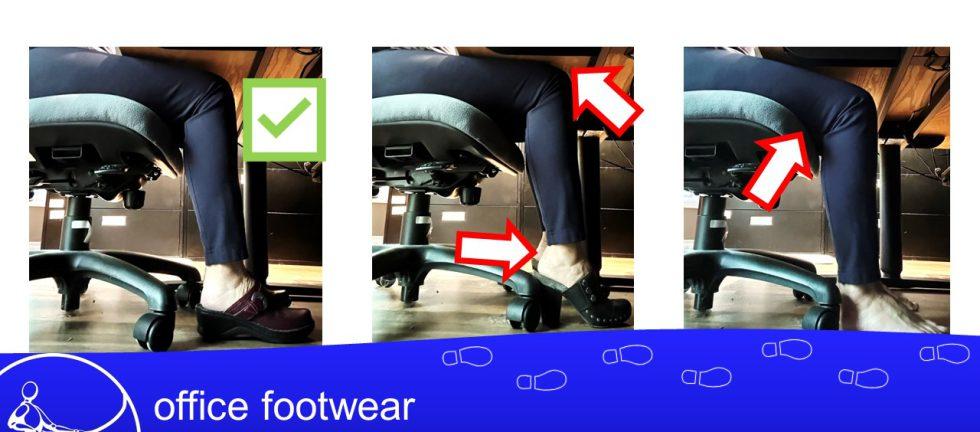Office footwear may appear to be an unconventional topic for an ergonomics blog, but shoes are quite important in creating a comfortable and productive workspace. While industrial and non-slip footwear are more commonly associated with ergonomics, what you wear on your feet during office hours can impact your overall well-being and work efficiency.
Why your choice of office footwear matters for ergonomics:
-
- Proper seat height adjustments: When configuring your workstation, you will make adjustments to ensure ergonomic comfort, such as setting the seat pan height, keyboard height, and screen height. These adjustments are carefully designed to provide support for your feet, position the keyboard and mouse at elbow height, and align the screen at eye level. However, the type of shoes you wear during or after these adjustments can disrupt this balance.
-
- If you wear shoes shoes while setting up your workstation but later work without them, as shown at the far right in the image above, your feet won’t receive the necessary support. (The same thing happens if you wear heels during your adjustments and flats afterwards.) This can lead to discomfort, causing you to adopt awkward postures like slouching, perching on the chair’s edge, placing heels on casters, or crossing your legs—none of which are beneficial for your ergonomic well-being.
-
- On the other hand, if you configure your workstation without shoes, or with low heels, and then decide to wear thicker soles or heels, your knees may collide with the bottom of the keyboard tray (as shown in the middle image above), leading to increased pressure on your “sit-bones” due to the higher knee position.
-
- Proper seat height adjustments: When configuring your workstation, you will make adjustments to ensure ergonomic comfort, such as setting the seat pan height, keyboard height, and screen height. These adjustments are carefully designed to provide support for your feet, position the keyboard and mouse at elbow height, and align the screen at eye level. However, the type of shoes you wear during or after these adjustments can disrupt this balance.
-
- Standing at work: Many of us are exploring the advantages of standing while working. However, to successfully add standing into your work routine, you must choose supportive footwear. Sock feet, slippers, flat-soled shoes, and high heels limit your ability to stand comfortably.
-
- Enhanced mobility and chair movement: You should be able to move your chair in and out from your desk simply by shuffling your feet on the floor. Grippy treads facilitate the “foot-shuffling” motion.
-
- Consideration for heels: If you’re a fan of office heels, be aware of potential ergonomic concerns. Wearing heels can lead to an angled ankle when the shoe rests on the floor. While a footrest can neutralize this angle, you’ll only be comfortable when your feet are on the footrest. Any other position, such as turning sideways or getting into your chair, will lack proper support.
Conclusion: Although office footwear might not be the first thing that comes to mind when contemplating ergonomics, it plays a pivotal role in creating a comfortable and productive workspace. Think about your shoes while configuring your workstation, embracing more standing, ensuring mobility, or considering your fashion choices. The right office footwear can enhance your ergonomics and overall job satisfaction.
For those interested in diving deeper into office ergonomics, we invite you to join our upcoming office ergonomics workshop scheduled for September 28 in Cambridge. Register here to learn how to optimize your workspace for comfort and productivity.


